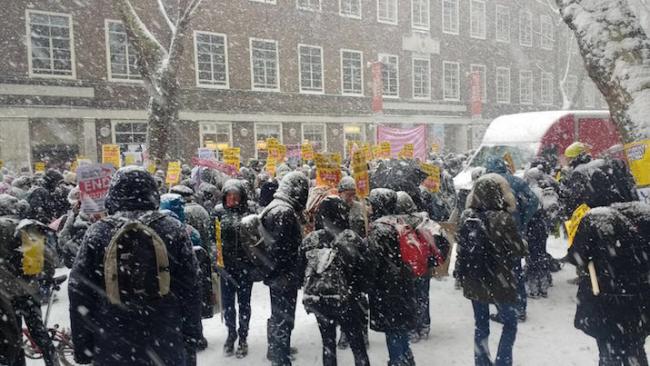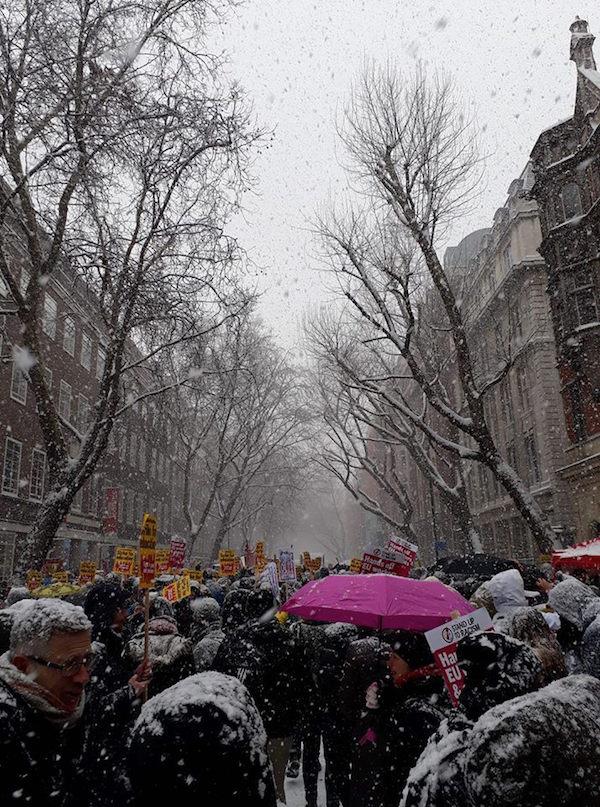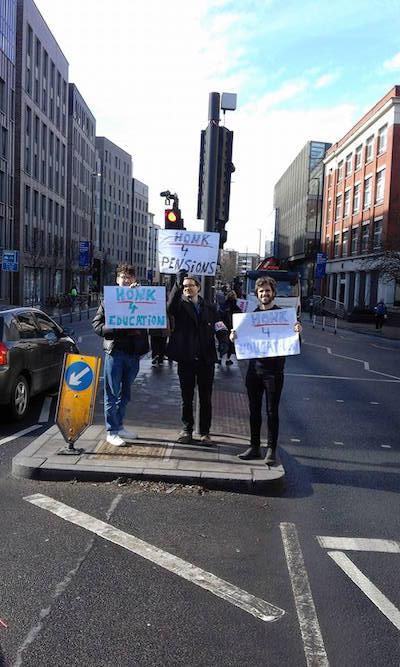
Myriad trans-Atlantic labor connections spring to mind for us as Latin Americanists participating in the largest strike in the history of Britain’s higher education sector. The fracas began in late February and will involve at least 14 days of strike action over four weeks at 61 universities across the country. Our battle is over pensions in the first place, but it also concerns the future of public higher education, the labor movement, and the wider struggle against austerity in the country.
“The university pensions dispute,” University of London Professor Brendan McGeever pointed out, “has underscored the transformative capacity of strike action…At ‘teach outs’ and picket lines across the country, the question of pensions is being located in a much wider conversation about the nature of the university and the marketization of higher education,” he said. The strike “has revealed itself to have the capacity to enlarge collectivism and deepen critical thinking.”
There are many parallels to similar struggles in Latin America. We reflect on our years of learning from the militant workers’ meetings of El Alto, Bolivia, and the lessons we gleaned from these struggles as we walk the picket lines in the UK. We bear in mind the Chilean student movement. From its origins in the 2006 pinguíno revolt by high school students to the university uprisings that began in 2011, Chile’s student rebellion marked a watershed in recent Chilean history. Linking with worker struggles and challenging neoliberalism, Chilean students turned their demands for free education and public control over strategic industries into common sense in one of Latin America’s most economically conservative countries. In Colombia, 2011 also witnessed student revolts at an unprecedented scale, while further north in the Americas, the red-square symbol widely adopted in the Quebec student uprisings of 2005 became a hopeful symbol for public sector struggles against austerity around the world.
We are also connected by the economic rhythms of recession. In 2008, the worst crisis of global capitalism since the Great Depression began unfolding through the world market. In the United Kingdom, the effects of the crash were instantaneous. Following on the heels of a decrepit decade of cost-cutting under Tony Blair, a Conservative-Liberal Democratic coalition government led by David Cameron seized control in 2010 and kicked off an unrelenting austerity drive, a dynamic that has continued under the subsequent Conservative administration of Theresa May.
In Latin America, the effects of the global crisis proved more uneven. Mexico, Central America, and the Caribbean, deeply imbricated with the U.S. economy, were quickly hit as their primary export market collapsed as remittances from migrant workers, an essential source of revenue, depleted. In South America, the crisis arrived somewhat delayed, not least because a Chinese-driven commodities boom for mining minerals and agro-industrial products continued until at least 2011and until 2014 for oil and natural gas. Yet by 2011, China too entered an economic slowdown, related to the collapse of its U.S. and Eurozone export markets, with reverberating effects on South American economic growth.
The commodities boom, which had financed much of the social spending and progressive policies of Pink Tide governments across Latin America over the previous decade, unleashed a crisis of legitimacy for many Left and center-Left governments in the region when crisis struck. Rather than shift the costs of collapsing state revenues into capital through more aggressive taxation or appropriation, Pink Tide governments, in an ill-fated attempt to remain “credible” to large private investors, instead adopted austerity measures that hit the poor and working classes hardest. And as they alienated erstwhile supporters, capital returned to its traditional political home in center-Right or hard-Right political configurations, emboldening conservatives to retake power through the ballot box in Argentina, Peru, and Chile and through thinly veiled coups in Paraguay, Brazil, and Honduras.
The end of the Pink Tide and the rise of new Rights has ushered much of Latin America into the wintry waters of the global "age of austerity." At the same time, Latin American workers’ struggles are popping up once again in defensive response. Brazil witnessed its first general strike in two decades in 2017 as Michel Temer’s unelected government systematically gutted social gains made under the Workers’ Party, while in Argentina public sector workers face off against Mauricio Macri’s efforts to gut pensions and welfare. Further north, a wildcat teacher’s strike unfolded in West Virginia in late February 2018, potentially spreading to Oklahoma and elsewhere and leading the West Virginia governor to agree to a 5% pay raise for teachers. In Canada, teaching assistants are on strike at York University in Toronto, and support staff have walked out at Carleton University in Ottawa. Closer to the U.K., Finnish higher education workers have gone on strike at the University of Helsinki for the first time in history. If the forces of austerity thought they could advance unchallenged, clearly they have been proven wrong.
The U.K. Pension Strike
At the heart of ongoing strikes in the U.K. are proposed changes to the Universities Superannuation Scheme (USS), one of Europe’s largest collectivized pension funds. Last year, a review of the fund by USS trustees ostensibly revealed a £7.5 billion ($10.4 billion USD) deficit. To ensure the fund’s viability, trustees determined that an increase in combined contributions by employers and employees from 26% to 37.4% of income was required. In response, Universities UK (UUK), which organizes groups of higher education employers, proposed to effectively eliminate guaranteed pensions by directing all contributions to the stock market, passing on risk from employers to employees. According to an independent estimate commissioned by the University and College Union (UCU), which represents university faculty and staff, the proposed changes would slash the pension of a typical faculty member by over £200,000 ($275,000 USD).
The USS’s calculations are rife with problems, though the UUK has deemed them objective. For instance, they project annual salary increases of 4.4 % by contributing faculty over their careers, when in fact faculty salaries have decreased by 14.5 % nationwide in real terms since 2009. (For faculty in London, the decline is steeper still). USS figures also project rising life expectancies for employees, though life expectancy has remained steady in the U.K. over the past five years. More incredibly, the USS factors in its own collapse, a worst-case scenario in which all UK universities go bust, leaving the USS to pay out pensions all at once. At an open staff meeting with Colin Bailey, President of Queen Mary University who has vouched for the accuracy of the USS figures, a member of the physics faculty in the audience quipped that by his calculations the probability of such a doomsday collapse, was lower than an asteroid striking London.



Then there are the politics behind proposed changes. The USS had originally projected a lower budget deficit of £5.1 billion in September. But 42% of UUK members rejected that estimate, calling instead for a new figure based on more conservative, less risky projections. Two months later, UUK and USS executives announced the current £7.5 billion deficit estimate, effectively calling into question their entire initial methodology. But UUK and USS at once refuse to release exact figures and intransigently cling to their estimates. Moreover, doubts about the numbers have grown since news emerged that the 69 colleges that comprise Oxford and Cambridge universities rejected the initial USS estimate, “to lend [their] balance sheet to the sector,” or carry water for less affluent institutions. It is a position that well reflects a new outlook for higher education in this age of austerity, placing the wants of accountants and investors above the needs of staff, students, and faculty who are the lifeblood of universities.
More and more, U.K. universities are not only turning to the market for financing; they are themselves becoming markets. Oxford, for example, raised £750 million ($1 billion USD) earlier this year by issuing its first 100-year bond, effectively turning the venerable university into a financial institution. In this sense, passing pension risks from employers to employees makes universities a more attractive investment. Proposed changes to the USS represent nothing less than the reorientation of universities away from staff and students towards investors. Overseeing this transformation is a new and expanding layer of university administration, which has seen its financial benefits increase over 200% since 2010. Predictably, as in the private sector, these bureaucratic parasites—a species that thrives in the environment of a market-driven academia—defend their fattening wallets as just rewards for bringing market rationality to higher education. Still, changes to pensions are but a part of the gradual neoliberalization of U.K. universities. Rising tuition transforms students into consumers and universities into service industries. From cleaning to catering to teaching, university services are being outsourced and staffed by contingent labor.
Why We Must Win, And How We Will
Gauging from the first two weeks of strikes, this is a different fight from prior experiences. Three earlier pension-related strikes by the University and College Union (UCU) over the past decade had uneven support, gained little momentum, and ended with union leaders caving to employers’ demands. But this is a new moment. Nationwide turnout is massive; students and staff have joined pickets in large numbers, organized petitions, and written letters to university councils, local politicians, and university presidents. And unlike previous moments, this time UCU leadership has continued to support strike actions even as negotiations are underway, understanding them to be critical leverage to achieve a just deal.
Teach-outs have transformed pickets themselves into spaces of learning. For the many students and staff who are new to strike action, these spaces have become consciousness-raising hubs. We have seen no shortage of energy and creativity from activists across the country, due in no small part to the introduction of free full UCU membership for graduate teaching assistants last October. As happened in Chile when pinguíno protesters grew up to become university revolutionaries, many of these new UCU members cut their teeth as activists during the militant and mass-based student demonstrations of late 2010.
Meanwhile other sectors of the trade-union movement, in the U.K. and abroad—including teachers in West Virginia—have also backed the strikes. Students, too, have stood in support. A recent yougov poll found that 61% of students back the strike, while only 2% fault faculty. Moreover students have proved invaluable activists, doing the small but vital tasks that sustain effective strikes. In the packed Annual General Meeting of the University of Queen Mary Students Union in London, held in the first week of the strike, a motion supporting the strike action and calling for student mobilization in solidarity passed with 98% support. The sense that these changes go too far and cut too deep is widespread. Even the Financial Times showed sympathy for striking faculty and questioned the USS calculations. After only one day of strike action, fourteen university presidents–including Cambridge University’s–broke ranks to criticize the UUK.
Much remains uncertain. The British labor movement is in frank decline. Days lost to strikes in the U.K. are at an all-time low. “And yet,” as McGeever suggests, “from this undoubted position of weakness, the 2018 university pensions dispute has shown that the withdrawal of labor still carries tremendous leverage.” Yesterday at the Queen Mary picket line, the sun had returned after last week’s bitter and snowy cold. Spirits were high as we walked away at noon to write this report. Bellicose voices of two women strikers on mega-phones led everyone through a variation of TLC’s “No Scrubs:”
No, I don’t want no scab
A scab is a guy that can’t get no love from me
Hanging out on the manager’s side of the picket line
Trying to holler at me
Cars honked in support. Union leaders felt compelled to reiterate, in case anyone doubted, that despite negotiations strikes would continue. This time is different. Unlike the last three U.K. strikes in higher education, this one we can win. This one we must win.
Angus McNelly, whose work examines class, state, and space in Bolivia under Evo Morales, is a PhD candidate and graduate teaching assistant in the School of Politics and International Relations at Queen Mary University of London. He has written for Constellations, Viewpoint, and others.
Jeffery R. Webber is a Senior Lecturer in the School of Politics and International Relations, Queen Mary University of London. His latest book is The Last Day of Oppression, and the First Day of the Same: The Politics and Economics of the New Latin American Left (Haymarket, 2017).

